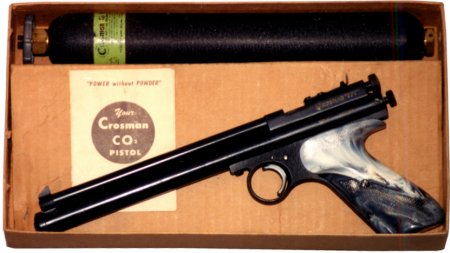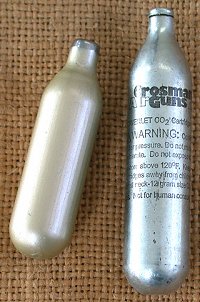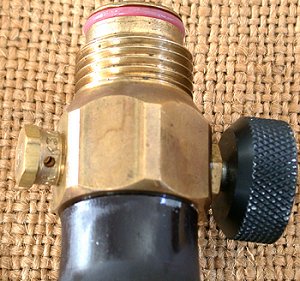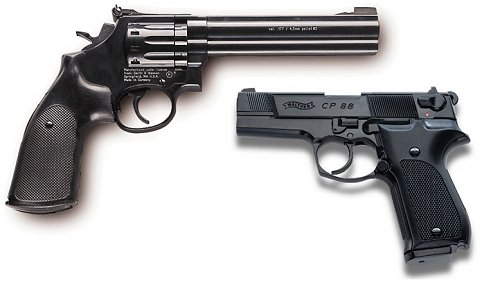HomeArticles
CO2 is used to power many air guns
What About CO2?(December 2003)
By Tom Gaylord
exclusively for PyramydAir.com. © Copyright 2003 All Rights Reserved
What about CO2?
A plain look at an intriguing gun powerplant
Carbon dioxide, or CO2, has been used to power guns since at least the 1870s, when Frenchman Paul Giffard first used it in his 6mm and 8mm gallery guns. In Giffard's day, CO2 was such a novelty that those who bought his gun had to send their cylinders back to a central filling station. There were no places to buy the gas conveniently.
In the late 1940s, Crosman marketed whole shooting galleries to companies, as entertainment for their employees. These eight-gun ranges were much less costly than even a one-lane bowling alley, plus they went into much less space. Lunchrooms were converted to shooting galleries, and league shooting was sponsored by the company.

In the 1940s, Crosman adapted 4-oz. military CO2 bottles to their "Silent" pneumatic rifle, which is the gun that collectors now call the CG (compressed gas). They never sold them to the public. They were part of a shooting gallery marketing plan Crosman pursued for a few years after WWII. The guns came with a tank that hung straight down (as shown) and one that hung slanted to the rear. They were made in a proprietary .21 caliber as well as the more conventional .22. This was America's first CO2 airgun experience |
The guns used for this sport were standard Crosman pneumatic rifles, converted to accept 4-oz. CO2 bottles that the company bought cheap as war surplus. These guns were never sold directly to the public, as the marketing campaign was centered on the sale of an entire gallery and not individual guns.
Today, these CG (for compressed gas) guns are collector's items, but the concept has been reborn in the Crosman AirSource guns. Shooters can now gas up their rifles with enough for more than 300 shots - something the all-day hobby shooters will love!

Crosman has now come full circle and is offering a bulk-filled CO2 rifle once again. This 1077 is adapted to use the new 3.2-oz. AirSource bottle, as well as conventional 12-gram powerlets. With the AirSource bottle attached, hundreds of shots are available. A valve permits removal while the bottle still has gas. |
Before we move on, let's clear up a question. Is a CO2 gun an airgun? If you mean, does it use air to power the shot? If so, then, no - it's not an airgun. But, that's a very limited definition and few people adhere to it today. Instead, most folks accept the definition of an airgun being a gun that uses something other than burning gunpowder to power the shot. In that sense, yes, a CO2 gun is an airgun.
The Powerlet
Benjamin was making CO2 guns that used commonly available 8-gram CO2 cartridges called "Sparklets" as early as the late 1940s. Sparklets were commonly used in seltzer bottles, which were very much in vogue at that time.

After the CG guns, Crosman brought out a series of bulk-filled CO2 pistols and rifles that lasted into the mid-1950s. This .177 model 111 still has its original box, 10-oz. bulk tank and instruction manual. The gun was holding gas when I purchased it at a flea market! |
Crosman was also making CO2 guns for general sale, but they were more like Giffard's guns, because they were filled from a separate 10-oz. bulk tank that had to be sent off to be refilled. Today, such guns are called bulk-fill guns, and they're still being made, though not by Crosman.

The small 8-gram cartridge known as a Sparklet is dwarfed by the more popular 12-gram powerlet from Crosman. Since Crosman invented the 12-gram size, the term powerlet now applies to all cartridges of that size, regardless of who makes them. |
In the middle 1950s, a Crosman employee converted one of their bulk-fill pistols to take a new, larger 12-gram CO2 cartridge and the Crosman 150 was born. It's no longer made, but the proprietary cartridge still is - and it's known all over the world by the name Crosman gave it - powerlet!
Probably 95 percent of all CO2 guns made today use a 12-gram powerlet. Powerlets are produced all over the world, and the name has lost its direct ties to Crosman by such universal acceptance.
How many shots you get from a powerlet depends on how much gas the gun uses for each shot. A rule of thumb is that a sporting pistol will give about 50 to 60 shots and a sporting rifle will give 40 to 50 shots. The exceptions to this rule are strange guns like the Czech APP 661, which has a very restrictive valve and gets over 100 shots at about 225 f.p.s.
CO2 and Pressure
CO2 is a gas at temperatures above -69.9 degrees F and 60.4 psig (pounds per square inch gauge). It is a very complex compound with the ability to sublimate (change directly from a solid to a gas without becoming a liquid) as just one of its unique properties.
At 70 degrees F, CO2 obtains a gas pressure of 852.8 psi when confined in a vessel. If there is more CO2 in the vessel, it will be have to be in liquid form. So, the state of CO2 in a pressure vessel, such as a powerlet at room temperature, is a pressurized gas above a liquid. If the gas is released, such as through the operation of an airgun valve, some of the remaining liquid flashes to gas until the pressure is equalized for that temperature.
It's important to understand that CO2 pressure is determined by temperature, not by mechanical compression. If you were to compress gaseous CO2 by mechanical means, it would turn into liquid when the right pressure was reached. The pressure in a 12-gram powerlet remains constant until all the liquid is gone. A powerlet has the same internal pressure as a 10-oz. bulk CO2 tank when both are at the same temperature. Therefore, CO2 guns do not lose velocity as you shoot them until all the liquid is gone and they start to run out of gas.
Also, keep in mind that CO2 is a refrigerant gas. That means it cools when it expands by flashing from liquid to gas. Therefore, when you shoot a CO2 gun rapidly, the gas will cool the gun parts considerably. Because CO2 pressure is based on temperature, the pressure in a CO2 gun will drop if a series of shots are fired in rapid succession. In practical testing, I've seen velocities decrease by more than 100 f.p.s. over a long string of shots. That will affect where the pellet strikes the target unless it's very close to the shooter. So, if you want to shoot accurately with a CO2 gun, do not shoot rapid-fire. With a target pistol, I like to allow at least 15 seconds between shots so the gun's temperature can cycle back to where it was before the shot. But, if you're just plinking, you can shoot faster than that.

DOT regulations require the use of a burst disk in pressure vessels larger than two inches in diameter. The brass nut with the hole in the side contains the burst disk in this bulk CO2 tank. If pressure inside the tank rises above the safety level, the disk ruptures, releasing all the gas inside. That keeps the entire bulk tank from exploding with the force of a bomb. |
On a very hot day, CO2 pressure will climb rapidly into the danger region. Where that danger region is, depends on how much liquid is in the pressure vessel. Larger CO2 tanks have pressure-relief devices for safety; so, instead of the whole tank blowing apart like a hand grenade, the burst disk will rupture and exhaust all the gas. When this happens, it's very startling to anyone nearby, and the tank has to be repaired before it will hold CO2 again. Obviously, it's unsafe to leave a CO2 gun or a tank in a closed car on a hot day.
How fast does my gun shoot?
With some types of airguns, this can be difficult to answer without actually measuring the shots with a chronograph. But, with CO2 velocity depends on just a few variables. With experience, you can estimate how fast a CO2 gun will shoot accurately just by knowing a few things. A short barrel shoots slower than a longer one. A pistol with a 4" barrel will shoot between 250 and 375 f.p.s. Since there's no easy way to increase the pressure and there's not enough barrel length to use the extra pressure even if it could be increased, this range describes most guns pretty well. A pistol with a 5" barrel will get around 400 to 500 f.p.s. in .177 and 350-450 f.p.s. in .22.

Umarex, the company that owns Walther of Germany, makes several realistic CO2-powered copies of famous firearms. The S&W 586 revolver will shoot faster than the Walther CP88 pistol because it has a longer barrel. |
In a .177 rifle with a 20" barrel, 675 to 750 f.p.s. is common. In .22-caliber with the same 20" barrel, 575 to 675 f.p.s. is common. I've seen some .22-caliber Philippine CO2 rifles with slightly longer barrels get over 900 f.p.s on a very hot day, but on a milder day (less than 85 degrees F) they shoot in the low- to mid-800 f.p.s. range. These guns have wide-open valves and were built to shoot as fast as possible. By wide-open valves, I mean that the orifice through which the gas flows is as large as it can be and the valve's return-spring is balanced against the weight of the hammer and the power of the mainspring to hold open the valve as long as possible.
The key to higher velocity with a CO2 gun is both high ambient temperature and a long barrel. And, this type of powerplant usually does much better in terms of raw power with the heaviest pellets. That also means that .22 caliber is preferred over .177 when power is needed.
CO2 facts
1. CO2 guns do not lose velocity as they shoot.
The first two or three shots will be faster because some of the liquid CO2 is blown into the firing valve and expands there or in the barrel, increasing the density of the gas charge. After that, you get a long string of shots at the same velocity. The only thing that can reduce velocity during this string is rapid fire shooting, which cools the gun. Slow down to allow the gun to warm up, and the velocity will pick up again.
At the end of the liquid CO2, the remaining pressure will begin to drop rapidly and velocity will start going down. After that, velocity will decrease until the gun is recharged or a new powerlet is installed.
2. CO2 guns will not operate well with other gases. To operate correctly, a CO2 gun needs a constant pressure level around 900 psi. Only CO2 will give that pressure at room temperature. Also, the valve's dwell time for a CO2 gun is MUCH longer than for an airgun running at a similar pressure, because the carbon dioxide molecule is so much larger than any of the gas atoms found in air. If you were to pressurize a CO2 gun to 900 psi with regular air, you would get one or possibly two powerful shots, then the velocity would drop off rapidly. Air, being much thinner, flows through a valve faster, which gives higher velocity until the pressure drops off.
3. Some CO2 guns require the removal of their powerlets after shooting.
And, some don't. I've shot CO2 guns that had been charged with gas for at least 20 years and they still shot like new. The time a gun can stay charged depends on its design and construction. Follow the manufacturer's recommendations at all times.
4. A CO2 gun depends on its seals to hold in the gas. Most of those seals are O-rings of some kind. O-rings need a thin film of oil to do their job, and they like silicone oil the best. Silicone oil for this purpose is sold by Crosman, Daisy and Gamo.
5. CO2 pressure - and, therefore, velocity - depends on temperature.
When the weather is warm, the gun shoots faster. Shooting indoors on a cold day allows you to shoot during cold weather.
6. Barrel length determines velocity to a great degree.
In this respect, CO2 acts exactly like black powder. Both need time to do their thing, and the longer the barrel (to the point of diminishing returns), the faster they shoot.
7. A powerlet and a large CO2 tank have the same internal pressure at the same temperature.
This is a difficult concept to grasp, but it's the reason CO2 powerlets are such a wonderful power source. They hold enough liquid for many shots, yet they're small enough to be very handy.
8. A CO2 gun cools when shot rapid-fire, which means lower velocity.
There is no way around this. You have to let the gun warm up for a few seconds between shots if you want a consistent velocity level.





